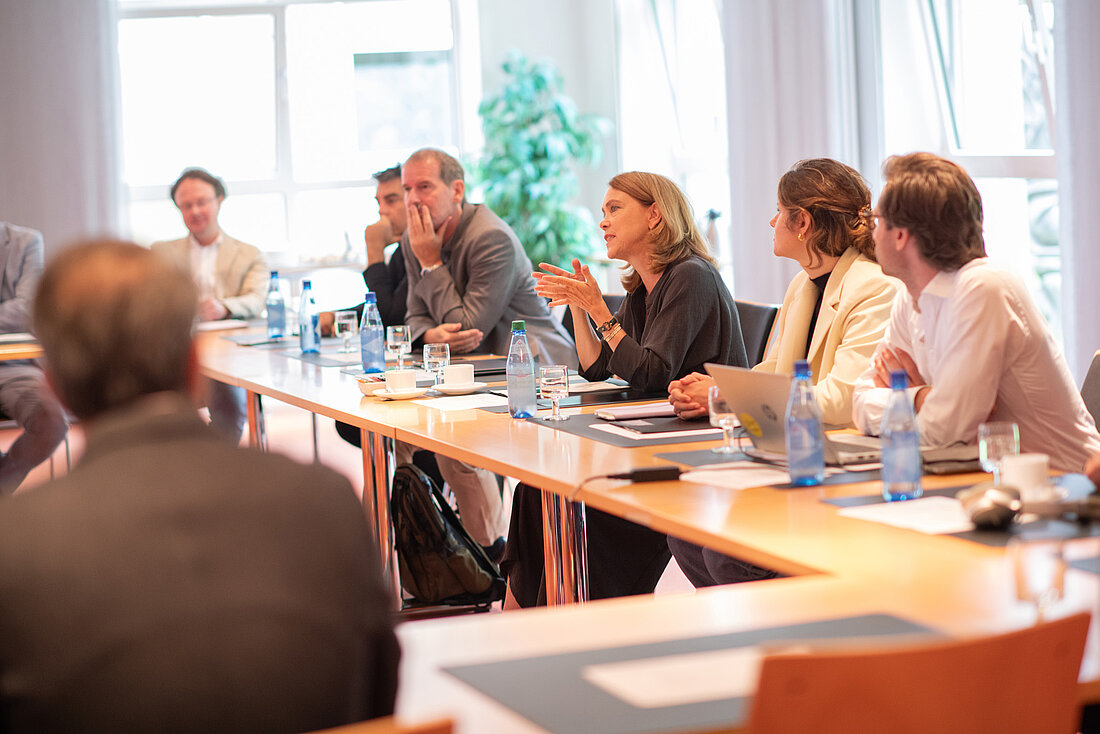Science Minister Petra Olschowski visits Ulm

What comes after the lithium-ion battery? How can solar energy be stored chemically? And how can the energy transition be successfully implemented? Researchers at the Green Energy Campus in Ulm's Science Park are investigating these questions: This is where the energy storage systems of the future are being created from sustainable materials. Baden-Württemberg's Minister of Science, Petra Olschowski, was able to see this for herself on Friday, September 6: as part of her summer tour under the motto “How do we want to live together in the future?”, she visited Ulm University and the Helmholtz Institute Ulm and spoke with employees and young researchers.
Reliable electrical storage systems such as batteries and efficient energy conversion systems such as fuel cells are key to the energy transition. Science Minister Petra Olschowski gained a wide range of insights into research into the energy storage systems of the future during her visit to Ulm University and the Helmholtz Institute Ulm (HIU) on Friday. The first stop was the university's Senate Hall, where Vice President Professor Michael Kühl welcomed the Minister and Professors Axel Groß and Maximilian Fichtner presented research into electrochemical energy storage systems in the city of science.
The focus was particularly on the work on sustainable battery materials at the HIU and in the Cluster of Excellence Post Lithium Storage POLiS, the first and only Cluster of Excellence for battery research in Germany, for which the Karlsruhe Institute of Technology (KIT) and Ulm University have just submitted a continuation application. “The development of innovative energy storage systems is of great importance for the success of the energy transition. The science city of Ulm has developed into an internationally visible beacon of energy research: The urgently needed energy storage systems and converters of the future are being created in this research environment with the development goal of sustainability and recyclability,” said Science Minister Petra Olschowski. “I am keeping my fingers crossed for Ulm University, KIT and their strong partners for the continuation of the unique Battery Cluster of Excellence. The state will also continue to support energy and battery research to the best of its ability.”
More than 30 years of experience in basic research
The Head of the Institute of Theoretical Chemistry, Professor Axel Groß, emphasized that it is not a matter of course that Ulm is now playing in the Champions League when it comes to electrochemical energy storage: “In the 1990s, electrochemistry was considered old-fashioned - but Ulm University developed it anyway. Today, it benefits from more than 30 years of basic research and occupies an exceptional position in Europe. With around 500 employees, Ulm is also home to the largest site in Germany in this field, added Professor Maximilian Fichtner. The Managing Director of HIU not only mentioned the successes of the POLiS Cluster of Excellence to date, but also explained the objectives for the second funding period applied for. In future, research will no longer focus on individual components, but on the complete cell. And Ulm is to become the world's leading post-lithium battery research center. A decisive factor for this is interdisciplinary cooperation: with the KIT and the Center for Solar Energy and Hydrogen Research Baden-Württemberg (ZSW) as well as with the Ulm site of the German Aerospace Center (DLR) as part of the HIU and the CELEST network. Afterwards, Minister Olschowski visited several laboratories at the Helmholtz Institute Ulm and talked to young scientists and employees.
The Minister's visit also focused on the excellence activities of Ulm University, which is not only applying for the aforementioned continuation of POLiS, but also for another cluster of excellence: With “Chem4Quant”, a joint initiative of KIT, Ulm University and the University of Stuttgart, an interdisciplinary team from chemistry and physics as well as computer and material sciences wants to develop atomically precise material structures for future quantum technologies. “We are very pleased about the Minister's support for our excellence activities,” says Vice President Professor Michael Kühl. “Through outstanding research on the pressing issues of our time, as we are doing at Ulm University, we are securing the future viability of our region.”
About the Helmholtz Institute Ulm (HIU)
The HIU Battery Research Institute was founded in January 2011 by the Karlsruhe Institute of Technology (KIT) in cooperation with the University of Ulm. With the German Aerospace Center (DLR) and the Center for Solar Energy and Hydrogen Research Baden-Württemberg (ZSW), two other institutions are involved in the HIU as associated partners. The international team of around 180 scientists at the HIU is researching the further development of battery materials for stationary and mobile use.
About the Post Lithium Storage Cluster of Excellence (POLiS)
POLiS is the first and so far only Cluster of Excellence for battery research in Germany. The abbreviation stands for “Post Lithium Storage Cluster of Excellence”. Scientists from KIT and Ulm University are conducting joint research into innovative battery materials that are no longer based on lithium. The cluster was approved in 2018 and endowed with 47 million euros for seven years. In 2025, the DFG and Science Council will decide whether the Cluster of Excellence will be extended for a further seven years. Associated partners are the ZSW and the University of Giessen.
CELEST energy storage research platform
CELEST is one of the largest platforms in the field of electrochemical energy storage. The “Center for Electrochemical Energy Storage | Ulm & Karlsruhe” - founded in 2018 by KIT, Ulm University and ZSW - networks scientific cooperation for battery and fuel cell development. More than 55 members from over 30 institutes worldwide are involved. In 2018, CELEST researchers succeeded in acquiring “POLiS”, the first and so far only Cluster of Excellence in battery research.
Further information, text and media contact
Christine Liebhardt, Head of Press and Public Relations at Ulm University, Mail: christine.liebhardt(at)uni-ulm.de, Tel.: (0731) 22121
